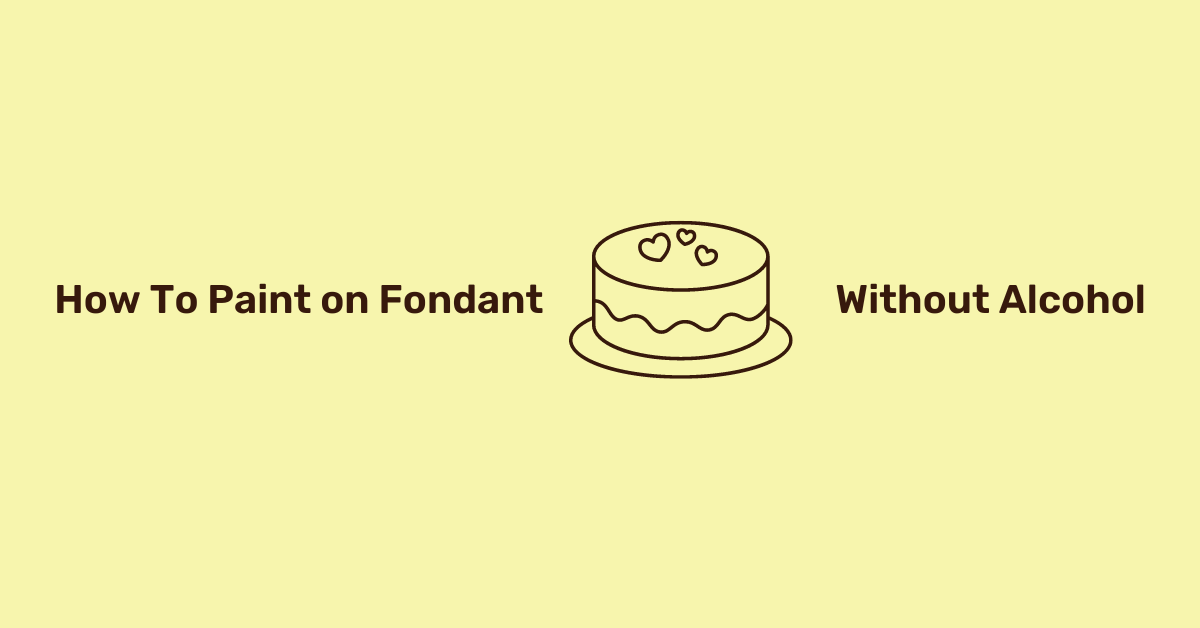How To Paint on Fondant Without Alcohol

Hand-painted cakes have become very popular among bakers and cake enthusiasts. While painting a cake becomes a canvas for bakers, people really do enjoy the aesthetic value brought to plain boring cakes. However, the most common way to create beautifully designed cakes is by painting on fondant, a process that involves alcohol. Learning how to paint on fondant without alcohol could be what you’re after if you’re not keen on using alcohol in your cake. Let’s do some digging and find out just exactly how!
We have some excellent alternatives that you can easily use to replace alcohol while still getting that beautiful finish you dreamed of.
Is It Possible To Paint Fondant With No Alcohol?
Yes! There are tons of ways you can paint on fondant without using alcohol in your cake. I know what’s going on in your mind! It is a common concern because alcohol is generally the most commonly used component for edible paint mixes.
When you mix alcohol with paint or luster dust, the alcohol evaporates quickly. It leaves behind a vibrant hue and a lot of sheen on your cake, making it look beautiful.
Using alcohol to paint your cake can give some of the best results. But you may not like to use alcohol to paint fondant for a number of reasons. Thankfully, there are a lot of substitutes in place that you can use to get similar results.
How To Paint On Fondant Without Alcohol?
Painting on fondant is a highly creative activity that allows bakers to experiment with shimmery and shiny paints to give their cake an edge. If you want to know how to paint gold fondant without alcohol, for example, here are your options:
Edible Paint With Lemon Juice
Lemon juice is a good option if you’re looking for non-alcoholic alternatives. Lemon juice is something you can easily find in your kitchen on any day you’re feeling the urge to get baking. As a substitute for alcohol, lemon juice works incredibly well since it will give you a similar finish as vodka but with a bit lesser of a shine.
Using lemon juice may require a few applications because the color fades a little. Also, it might dry without leaving a dust finish. This means you won’t be able to buff out any brush marks as easily as you would with alcohol. It will require a bit more time and effort than alcohol, but with a few coats, the difference between the two should be minimal.
Edible Paint With Water
If you want to combine your luster dust with anything that isn’t alcoholic, try just using plain tap water. Keep in mind that water does not evaporate like alcohol, however. Thus, it might soak into your dessert and distort the surface, so be very careful when using this method.
Water also produces a thicker paint than lemon juice, but the end result can be comparable. The brush strokes are easily visible, so you need to ensure you remove any extra paint before allowing it to dry. This process might take around 30 minutes.
When using water, it will not be as sparkly as the alcohol options, and it will dry with a matte sheen. The results are similar to lemon juice, but it still makes for terrific paint.
Pre-Mixed Edible Paint
A pre-mixed edible paint is another excellent choice if you don’t want to mix your colors like me. Although many of these may contain alcohol, some types of pre-made edible paint are alcohol-free. If you prefer a non-alcohol option, make sure to check the ingredients first.
The pre-mixed edible paint has a similar effect to vodka; it stays wet for a bit longer and feels somewhat waxy when dried, but it leaves a nice sheen. It will be pretty simple to get a shiny look because the gold is already pre-mixed, so you will only need to add little quantities of it.
For more advanced cake decorating projects, the painting might require you to use at least two coats, just like vodka.
Cocoa Butter And Shortening
You can do the painting with mediums like cocoa butter and shortening as well. However, the finished results can readily smear with shortening or melt with cocoa butter due to the waxy or oily nature of these materials.
Because of some of these setbacks, using these choices in the winter or a chilly setting is the ideal scenario since the cold weather lowers the chance of smearing and melting.
You may use blotting paper to absorb part of the grease while painting with shortening. Some colors do come off, but it all depends on what you’re painting and how big of a surface you’re working with.
Water can be utilized sparingly in tiny spaces. But it’s essential to be diligent about the fact that putting too much water on the fondant can cause it to break down or disintegrate. Paint in layers, allowing each coat to dry completely before moving on to the next to provide more favorable outcomes.
Final Thoughts
Fondant is something that most baking lovers like to experiment with. Not only can you make unique shapes and additions, but you can also paint on the fondant to make extravagant desserts. If the extensive use of alcohol is stopping you from painting on fondant, this guide on how to paint on fondant without alcohol is for you. Try any of the alternatives above and get creative with your cakes and cupcakes!

Ian Hoyt is a co-founder of Morsel – a family recipe cookbook software. When he isn’t working on building the best recipe app for your family Ian can be found hiking in the mountains of North Carolina, flying airplanes, or of course in the kitchen perfecting his beloved scone recipe.
